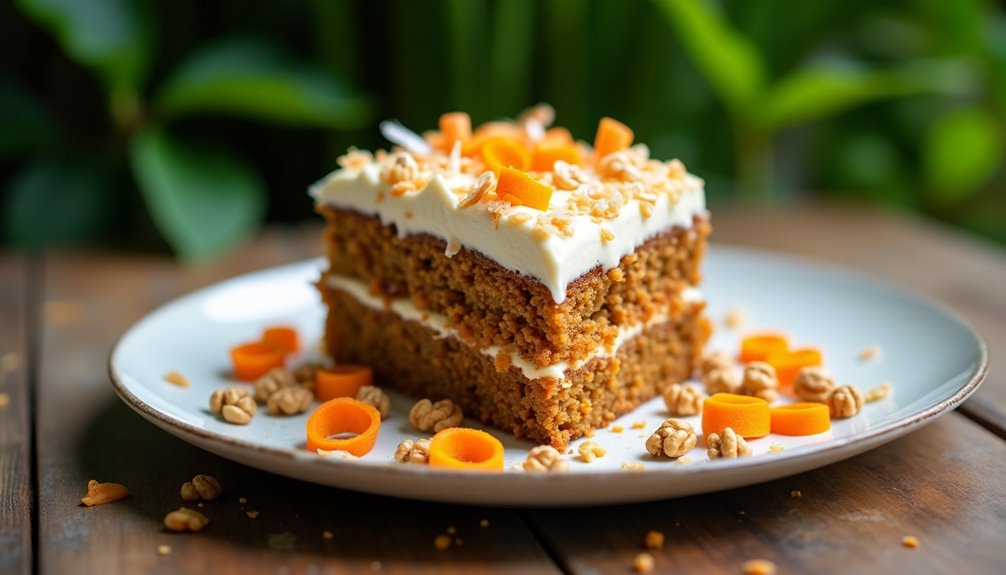Paleo carrot cake is a mouthwatering treat that lets you enjoy dessert without compromising your health. By using grated carrots for moisture and natural sweetness, along with almond or coconut flour as a base, you create a dense, satisfying cake. Eggs bind everything together while spices like cinnamon and nutmeg enhance the flavor. For the frosting, combine coconut cream with vanilla and a Paleo-friendly sweetener for a creamy finish. You can customize your cake by adding nuts or experimenting with different sweeteners. There's so much more to discover about crafting the perfect Paleo carrot cake and making it your own!
Key Takeaways
- Paleo carrot cake uses grated carrots for moisture and flavor, making it a nutritious dessert option.
- Almond or coconut flour serves as a healthy base, providing protein and healthy fats.
- Natural sweeteners like maple syrup or honey enhance flavor without refined sugars.
- Use spices like cinnamon and nutmeg to elevate the cake's taste profile.
- Top with a coconut cream frosting for a delicious, Paleo-friendly finish.
Benefits of Paleo Baking
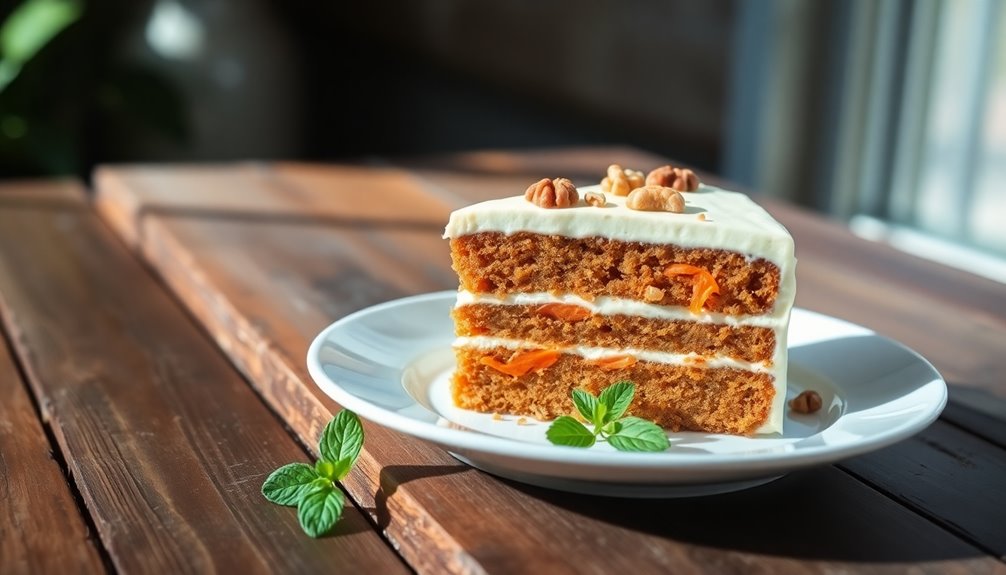
When you immerse yourself in the world of Paleo baking, you're not just swapping ingredients; you're embracing a healthier lifestyle. The health benefits that come with this approach are significant. By using whole, unprocessed foods, you're fueling your body with nutrients that promote energy and well-being. Gone are the refined sugars and unhealthy fats that can leave you feeling sluggish. Instead, you're opting for natural sweeteners and healthy fats, which can help stabilize your energy levels throughout the day.
But it's not just about health; the flavor profiles in Paleo baking are incredibly diverse and satisfying. You can experiment with ingredients like almond flour, coconut flour, and various spices, creating rich, delicious treats that tantalize your taste buds. Imagine savoring a moist, spiced carrot cake, where the natural sweetness of the carrots shines through, enhanced by warm cinnamon and nutmeg. Each bite can transport you to a place of comfort and indulgence, all while knowing you're making a nourishing choice.
As you embrace this lifestyle, you'll likely find a sense of community with others who share your passion for wholesome, delicious foods. Whether you're swapping recipes or sharing tips, you'll feel a sense of belonging that enriches your baking journey.
In the end, Paleo baking isn't just about creating delectable desserts; it's about nurturing your body and spirit, one scrumptious bite at a time.
Essential Ingredients Needed
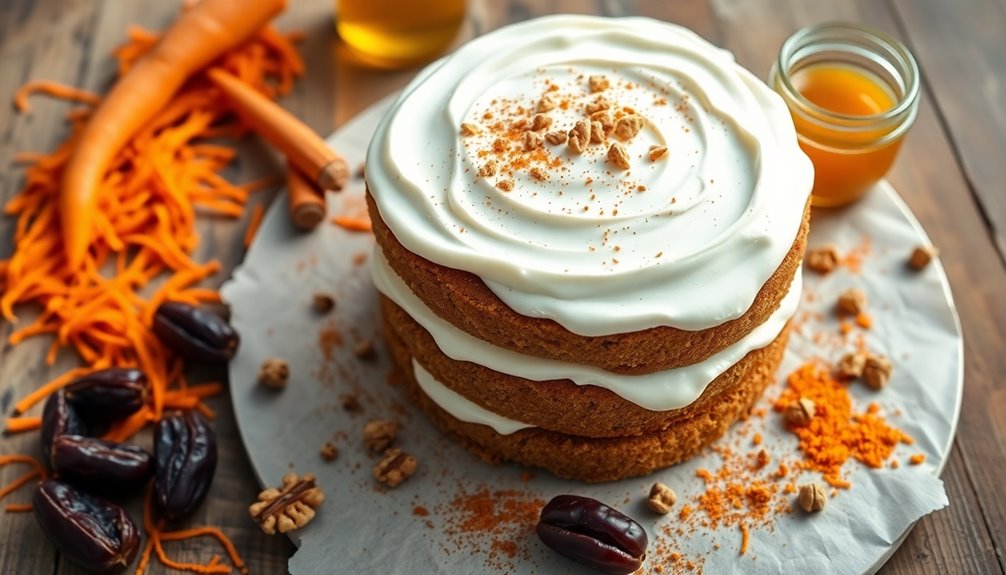
To create a delightful Paleo carrot cake, you'll need to gather a handful of essential ingredients that not only enhance flavor but also align with the principles of the Paleo diet. This cake celebrates the natural sweetness of carrots while incorporating healthy substitutions that keep it moist and delicious.
Start with fresh, grated carrots, as they're the star of the show. Next, you'll want to choose a nut flour, like almond or coconut flour, for a perfect base that offers a wonderful texture. Don't forget to include eggs, which bind everything together and add richness. For sweetness, opt for pure maple syrup or honey; both are fantastic flavor combinations that maintain the cake's integrity while providing a touch of indulgence. Additionally, spices like cinnamon and nutmeg will elevate the taste profile, bringing warmth and depth.
Here's a quick overview of the essential ingredients:
| Ingredient | Purpose |
|---|---|
| Grated Carrots | Main flavor and moisture |
| Almond/Coconut Flour | Healthy base for texture |
| Eggs | Binding agent and richness |
| Maple Syrup/Honey | Natural sweetener |
| Cinnamon/Nutmeg | Flavor enhancement |
Step-by-Step Preparation
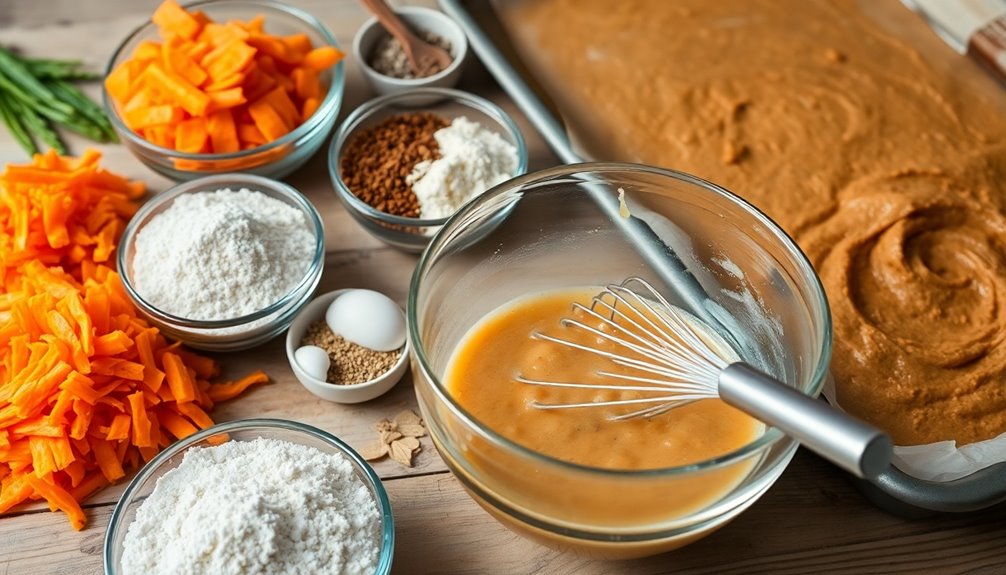
Creating a delicious Paleo carrot cake is a straightforward process that brings together the vibrant flavors of fresh carrots and warm spices. Start by preheating your oven to 350°F (175°C) and greasing your cake pans with coconut oil or parchment paper for easy removal.
In a large bowl, mix your dry ingredients: almond flour, baking soda, cinnamon, nutmeg, and a pinch of salt. This combination creates a delightful flavor profile that enhances the natural sweetness of the carrots.
Next, beat together your wet ingredients—eggs, honey, and melted coconut oil—until smooth. This is where you can get creative with ingredient substitutions; for instance, maple syrup works wonderfully if you prefer a different sweetness. Gradually fold your dry mixture into the wet ingredients, ensuring you don't overmix. Stir in grated carrots, crushed walnuts, and raisins for added texture and flavor.
Once your batter is ready, pour it evenly into your prepared pans and bake for 25-30 minutes. While it's baking, think about presentation ideas. A simple dusting of almond flour or a drizzle of coconut cream can elevate your cake beautifully.
When the cakes are done, let them cool completely before frosting with a delicious coconut cream frosting or simply serve them plain to highlight their natural flavors.
With these baking techniques, you're well on your way to creating a mouthwatering Paleo carrot cake that will impress your friends and family at any gathering. Enjoy the process and celebrate the flavors!
Tips for Perfect Texture
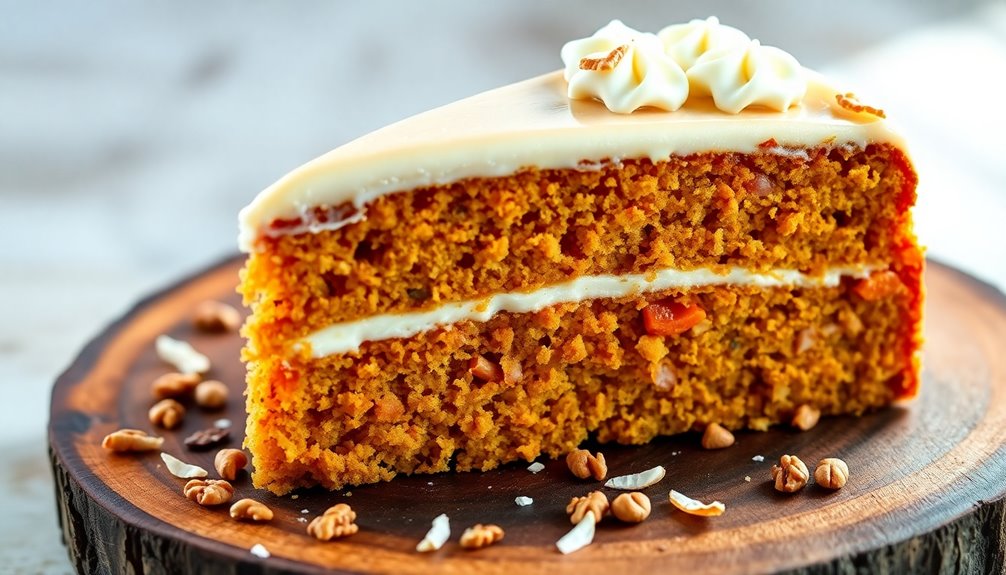
Achieving the perfect texture in your Paleo carrot cake can make all the difference between a good dessert and a truly memorable one. To get that delightful moistness and tenderness, pay attention to your ingredient substitutions and baking techniques.
Start with your flour choice. Almond flour works wonders, but if you want a lighter cake, consider incorporating a bit of coconut flour. Just remember, coconut flour is highly absorbent, so you'll need to adjust the liquid in your recipe accordingly. Using fresh, finely grated carrots will also add moisture and sweetness, enhancing your cake's texture.
When it comes to sweeteners, opt for maple syrup or honey instead of refined sugar. These natural alternatives not only lend a rich flavor but also contribute to a moist crumb.
Next, let's discuss baking techniques. Always preheat your oven to guarantee even baking. Using the right pan matters too; a light-colored, non-stick pan can help your cake rise beautifully without burning. Bake until a toothpick inserted into the center comes out clean, but don't overdo it, as that'll dry out your cake.
Lastly, let your cake cool completely in the pan before transferring it to a wire rack. This step helps maintain its structure and moisture. By following these tips, you'll be well on your way to creating a Paleo carrot cake with a texture that'll have everyone asking for seconds!
How to Frost Your Cake
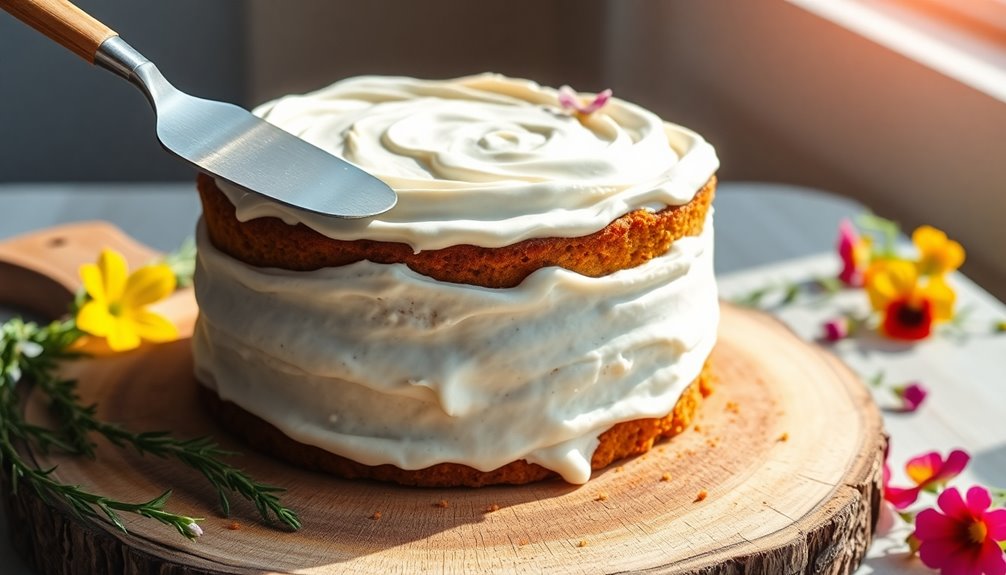
Frosting your Paleo carrot cake is where the magic truly begins, transforming a delicious dessert into a stunning centerpiece. To create that perfect creamy frosting, start by combining coconut cream, a touch of vanilla, and your choice of Paleo-friendly sweetener. Whip it together until it reaches a smooth, velvety consistency that's not just delightful to taste but also a pleasure to work with.
Once your frosting is ready, it's time to get creative! Begin by placing the first layer of your cooled cake on a serving plate. Spread a generous amount of that creamy frosting on top, allowing it to ooze slightly over the edges for a rustic look. Add the second layer and repeat the process.
Now, for the fun part—decorative techniques! Use a spatula or a piping bag to create beautiful swirls and peaks, elevating the visual appeal of your cake.
Don't hesitate to sprinkle some crushed nuts or shredded coconut on top for added texture and flair. If you're feeling adventurous, you can even add a few edible flowers for a pop of color. Remember, the goal is to make your cake not just taste amazing but also to look inviting, encouraging everyone to dig in and share in the joy of your creation.
With these simple steps, you'll have a frosted Paleo carrot cake that's ready to impress and bring everyone together around the table. Enjoy your masterpiece!
Alternative Sweeteners
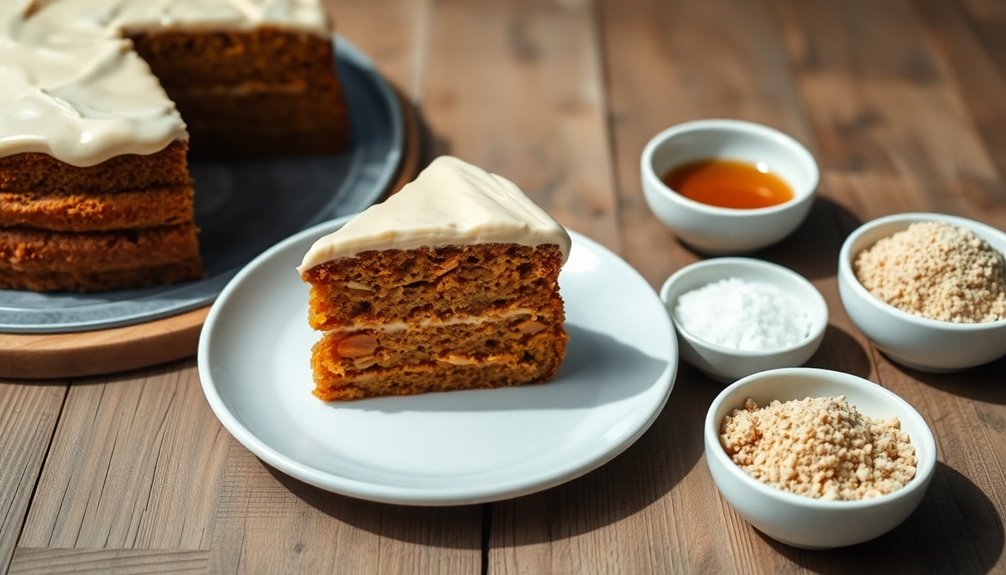
When it comes to sweetening your Paleo carrot cake, selecting the right sweetener can make all the difference in flavor and texture. Traditional refined sugars are off-limits, but don't worry—there are plenty of delicious sugar substitutes that can elevate your cake without compromising your dietary choices.
One popular option is coconut sugar, which brings a rich, caramel-like flavor to your cake. It pairs beautifully with the warm spices typically found in carrot cake, like cinnamon and nutmeg.
You might also consider using pure maple syrup or honey for a touch of natural sweetness. Both of these options not only enhance the flavor but also keep the cake moist, making each bite a delightful experience.
Another fantastic alternative is date sugar, which is made from dried, ground dates. It gives a deep, fruity taste that complements the carrots wonderfully. Plus, it's packed with nutrients!
If you prefer a liquid sweetener, try agave nectar—its mild flavor won't overpower your cake and blends seamlessly with other ingredients.
Don't shy away from experimenting with flavor combinations! Mixing sweeteners can create a unique depth; for instance, combining coconut sugar with honey can yield a pleasing balance of sweetness and texture.
Ultimately, the key is to choose the sugar substitutes that resonate with your palate while staying true to the Paleo lifestyle. With these options in hand, you're on your way to crafting a scrumptious Paleo carrot cake that everyone will love!
Serving and Storage Tips
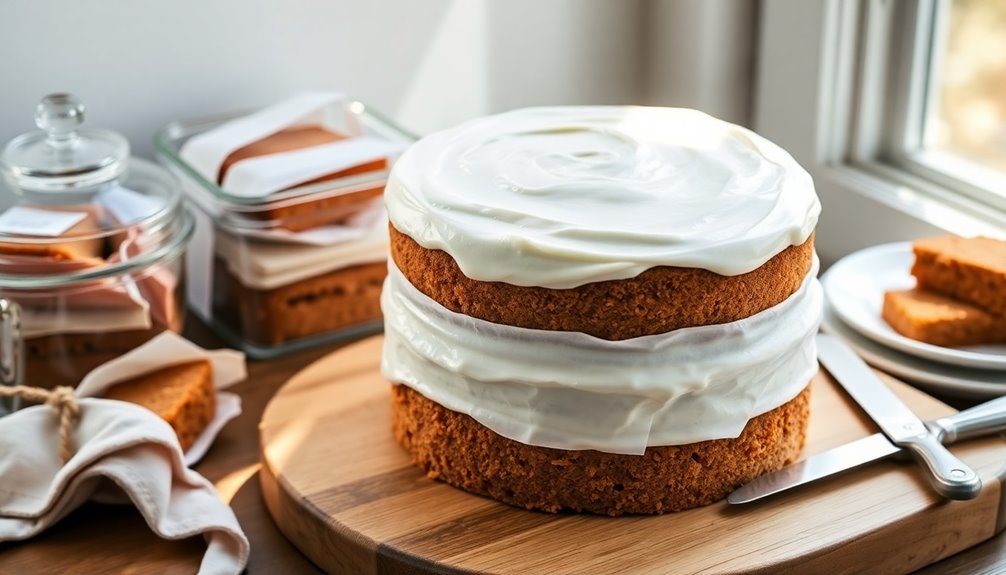
Once your Paleo carrot cake is baked to perfection, it's time to think about how to serve and store it for maximum enjoyment. Start by letting the cake cool completely before slicing it; this guarantees clean cuts and beautiful presentation.
When it comes to serving suggestions, consider topping each slice with a dollop of coconut cream or a sprinkle of chopped nuts. This not only enhances the flavor but also adds a touch of elegance to your dessert table.
For portion sizes, aim for slices that are about 1 to 2 inches wide. This allows everyone to savor the rich flavors without feeling overwhelmed. If you're hosting a gathering, consider serving the cake alongside fresh fruit or a light salad to balance the meal.
Now, onto storage options! If you have leftovers (which is rare, but possible), you can store your Paleo carrot cake in an airtight container in the refrigerator for up to a week. For longer storage, slice the cake and wrap individual portions in plastic wrap, then place them in a freezer-safe bag. This way, you can enjoy a slice whenever you crave it. Just remember to let it thaw in the fridge overnight before indulging.
With these serving and storage tips, you're all set to impress friends and family while maintaining your delicious creation fresh for future enjoyment. Enjoy every bite!
Variations to Try
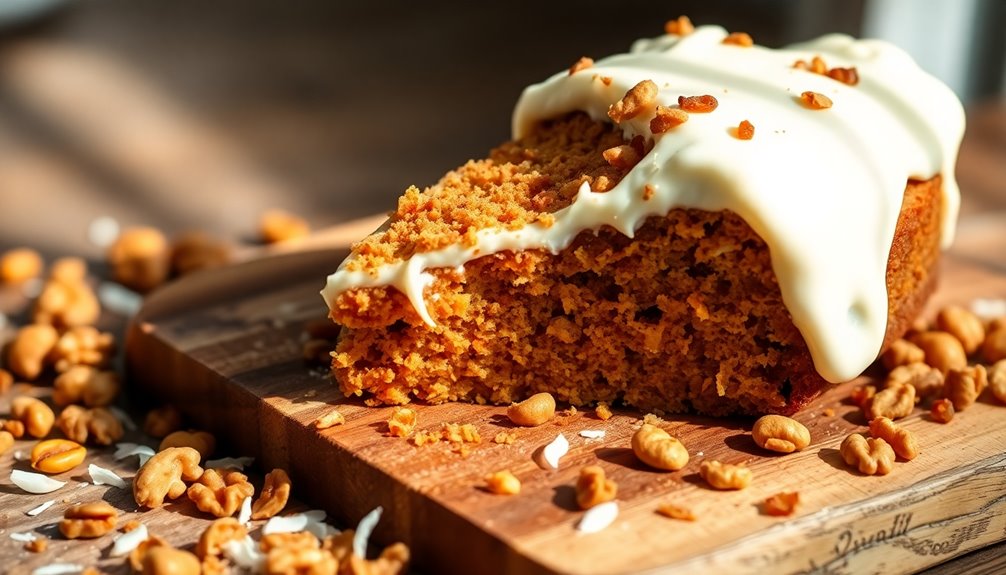
If you're looking to mix things up with your Paleo carrot cake, there are plenty of delicious variations to explore. Start by playing with flavor combinations that excite your taste buds.
How about adding crushed pineapple for a tropical twist? The sweetness of the pineapple pairs beautifully with the warm spices in the cake. You might also consider incorporating shredded coconut or chopped nuts like walnuts or pecans to create a delightful crunch.
Don't hesitate to get creative with ingredient substitutions, either. If you're not a fan of almond flour, you can swap it out for cashew flour instead. This change will give your cake a unique texture while keeping it Paleo-friendly.
You can also experiment with different sweeteners. Instead of honey, try maple syrup for a slightly different flavor profile that still satisfies your sweet tooth.
For those who enjoy a bit of tang, a splash of orange juice or zest can brighten the cake and complement the carrots beautifully. And if you're feeling adventurous, you could even add spices like cardamom or nutmeg for an aromatic kick.
Every variation you try brings you one step closer to discovering your perfect Paleo carrot cake. So don't be afraid to experiment; these tweaks can transform your cake into something truly special. Your friends and family will appreciate the effort, and you'll create lasting memories together. Enjoy the journey of baking, and let your creativity shine!
Nutritional Information
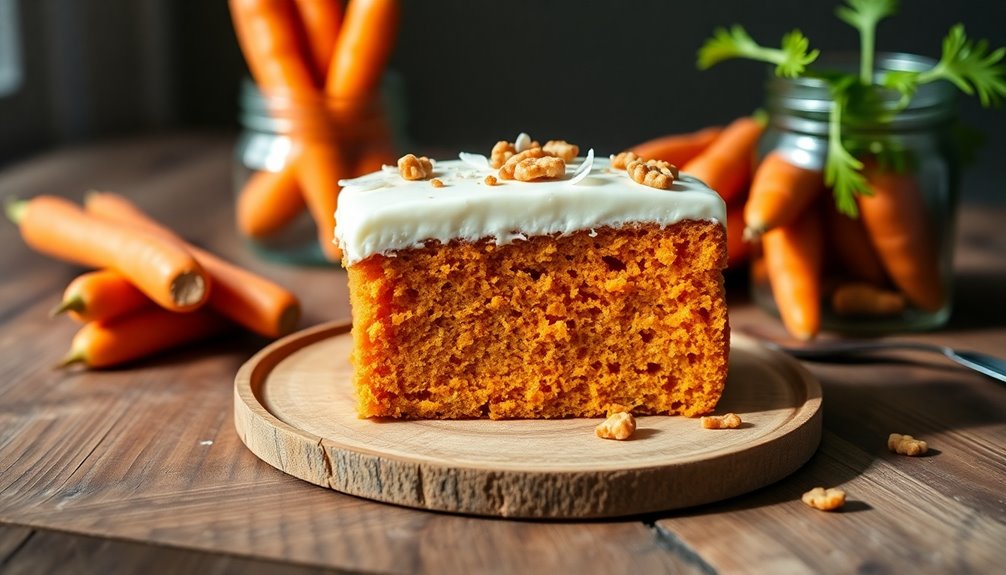
Exploring variations in your Paleo carrot cake not only brings excitement to your baking but also impacts its nutritional profile. By carefully selecting your ingredients, you can enhance the health benefits while still satisfying your sweet tooth.
For instance, using almond flour instead of traditional wheat flour offers a gluten-free option that's rich in protein and healthy fats, making it a wonderful choice for those seeking to maintain balanced energy levels.
When you think about ingredient substitutions, consider adding crushed walnuts or pecans for an extra crunch and a dose of omega-3 fatty acids. You could also swap out refined sugars for natural sweeteners like maple syrup or honey, ensuring that your cake stays true to the Paleo principles while delivering a lower glycemic index. This simple change can keep your blood sugar levels steady, allowing you to enjoy your dessert without the guilt.
Moreover, carrots themselves are a powerhouse of nutrition; they're packed with beta-carotene, which is great for your vision and skin health. You'll also appreciate the fiber content that aids digestion and keeps you feeling full longer.
Frequently Asked Questions
Can I Use Regular Flour Instead of Almond Flour?
You can't use regular flour instead of almond flour if you're adhering to certain diet restrictions. Almond flour is a staple in gluten-free and paleo baking techniques, offering a unique texture and flavor.
If you're looking for ingredient substitutions, consider using coconut flour or a gluten-free blend, but remember that these may require adjustments in liquid ratios.
Embrace the creativity in baking, and you'll find delicious alternatives that fit your dietary needs!
Is Paleo Carrot Cake Suitable for Vegans?
If you're wondering whether it's suitable for vegans, you'll find that with a few tweaks, it can be!
Substitute eggs with flaxseed or chia seeds, and use dairy alternatives like almond milk or coconut yogurt.
You can also explore flavor variations by adding spices or different nuts.
Embracing these changes not only keeps your dessert vegan but also brings everyone together to enjoy a delicious treat that's inclusive and satisfying!
How Long Does Paleo Carrot Cake Last in the Fridge?
If you store your cake properly in an airtight container, it'll last about 5 to 7 days in the fridge. To maintain freshness, check for signs of spoilage like an off smell or mold. If it starts to dry out or lose its flavor, it's time to say goodbye. For the best experience, enjoy it within the first few days, and follow these storage tips to maximize its shelf life!
Can I Freeze Leftover Paleo Carrot Cake?
Yes, you can freeze your leftover cake! For the best results, wrap it tightly in plastic wrap and then place it in an airtight container. This helps maintain flavor variations and prevents freezer burn.
When you're ready to enjoy it, thaw it in the fridge overnight. You might notice some texture adjustments, but it'll still taste great.
With these freezing tips, you'll always have a delicious treat waiting for you!
What Are Common Mistakes When Making Paleo Carrot Cake?
Picture a warm kitchen, the sweet aroma of spices wafting through the air. When making your cake, avoid common mistakes like using too much liquid or not measuring your almond flour properly. Stick to baking tips like checking your oven temperature.
If you're making ingredient substitutions, validate they're compatible with each other; otherwise, your cake might end up dense or crumbly. Embrace these tips, and you'll create a delightful treat that everyone will love!
Conclusion
In the world of baking, this paleo carrot cake stands out like a vibrant sunset on a crisp autumn day. You've discovered a delicious way to indulge without the guilt, savoring each mouthful of wholesome goodness. By following these tips and variations, you can create a treat that satisfies your cravings and nourishes your body. So, gather your ingredients and let your kitchen be the canvas for this delightful masterpiece—your taste buds will thank you!

